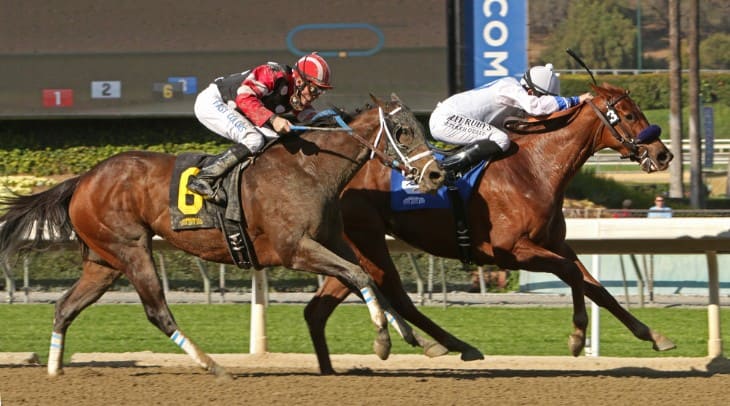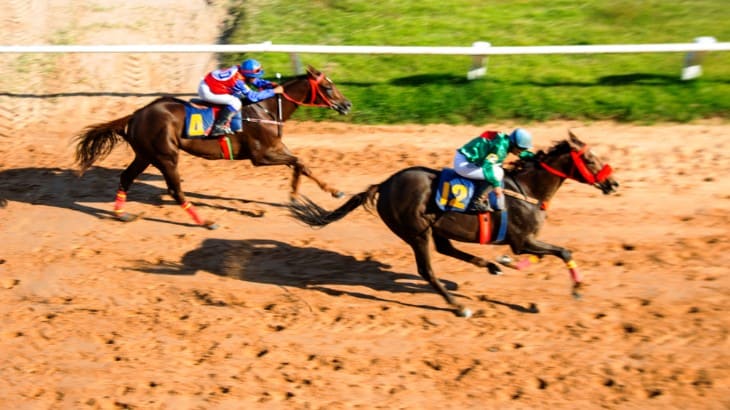In the heart of the equestrian world lies a pursuit that blends artistry with scientific precision – the breeding of racehorses. The quest to produce a champion racehorse is a delicate dance between tradition and innovation, guided by the principles of equine genetics and selective breeding. As we delve into this captivating realm, we embark on a journey to uncover the secrets behind the creation of these magnificent athletes.
The Art and Science of Equine Genetics
At the core of breeding exceptional racehorses lies a profound understanding of equine genetics. Each racehorse carries within its DNA a complex tapestry of traits that influence its speed, endurance, conformation, and temperament. The journey begins with a comprehensive examination of a horse's pedigree – a lineage that tells a tale of champions past and potential greatness. Studying the lineage reveals valuable insights into the genetic makeup of the horse, offering breeders a glimpse into the traits that may be passed down through generations.
Breeders meticulously scrutinize the pedigrees of prospective parents, seeking to capitalize on desirable genes while mitigating the risks of inheriting undesirable traits. It's a delicate balancing act that draws upon generations of equine knowledge, as breeders strive to create a seamless fusion between the art of horsemanship and the rigours of modern genetics.
Selecting Superior Bloodlines: Pedigree Analysis
In the world of horse breeding, pedigrees are akin to the blueprint of a masterpiece. Pedigree analysis involves tracing the lineage of a horse back through multiple generations, unearthing a treasure trove of information that shapes the horse's potential. This meticulous examination allows breeders to identify patterns of success, uncovering families of horses that consistently exhibit traits of speed, stamina, and prowess on the track.
A critical aspect of pedigree analysis is recognising the influence of 'sire' and 'dam' lines – the paternal and maternal sides of a horse's lineage, respectively. Successful sires and dams often pass on their exceptional qualities, creating a legacy that resonates through time. Studying these lines provides breeders with a roadmap to potential success, guiding their decisions in selecting the perfect pairing to maximise genetic potential.
Understanding Inheritance Patterns: Mendelian Genetics
As we dive deeper into the world of breeding winning racehorses, our voyage takes us through the intricate labyrinth of Mendelian genetics. Named after the pioneering scientist Gregor Mendel, this branch of genetics unravels the mechanisms by which traits are inherited from one generation to the next. Mendel's peas may have paved the way, but his principles extend seamlessly to the noble world of thoroughbreds.
The foundation of Mendelian genetics lies in the concept of alleles – alternative versions of genes that dictate the expression of a particular trait. Whether it's coat colour, speed, or conformation, each trait is governed by a pair of alleles inherited from both parents. The interplay between dominant and recessive alleles, and the intriguing dance of genotype and phenotype, crafts the distinctive identity of each individual racehorse.
Unlocking the Power of Genetic Markers in Thoroughbreds
In our quest to mould exceptional racehorses, modern science offers us a potent tool – genetic markers. These microscopic signposts scattered across the strands of DNA hold the key to unlocking the horse's potential in unprecedented ways. Genetic markers allow breeders to pinpoint specific traits with remarkable accuracy, enabling a refined approach to selective breeding.
The journey begins with genotyping – a process that reads the genetic code of a horse, identifying the markers associated with desired traits. From speed-enhancing markers to markers linked with endurance, breeders gain insights that were once hidden beneath layers of genetic complexity. Armed with this knowledge, breeders can now sculpt the genetic landscape of future champions, assembling combinations that resonate with the symphony of success.
As we stand at the crossroads of Mendelian genetics and the realm of genetic markers, we find ourselves on the brink of a new era in equine breeding. The delicate dance between ancient wisdom and cutting-edge science propels us forward, guiding our steps towards a future where the tapestry of traits in a winning racehorse is carefully woven through the threads of genetics. Join us as we continue to unveil the secrets that propel these majestic creatures towards the winner's circle, one stride at a time.

Breeding Strategies for Performance Enhancement
In the intricate world of breeding winning racehorses, strategy emerges as a guiding beacon. The knowledge gained from genetics and pedigree analysis becomes the brushstroke, and the breeding strategy the canvas upon which potential champions are painted. It's a careful fusion of science and intuition, where each decision holds the promise of shaping the destiny of generations to come.
Breeding strategies encompass a spectrum as diverse as the horses themselves. Linebreeding and inbreeding, for instance, harness the power of shared ancestry to amplify desirable traits, while outcrossing introduces fresh genetic vigour by pairing unrelated bloodlines. The delicate balance between preserving genetic diversity and concentrating sought-after qualities is an art that only skilled breeders can master.
But the intricacies don't stop there. The age-old debate between breeding for speed or stamina presents breeders with a formidable challenge. Do you opt for the swift sprinter or the enduring stayer? Each choice ripples through the generations, influencing the horse's potential on the track.
Optimizing Conformation and Athleticism in Racehorses
Beyond the intricacies of genetics, a horse's conformation stands as a silent testament to its athletic prowess. The art of crafting a winning racehorse extends to the shaping of its physical structure – a symphony of angles, proportions, and balance. Conformation is more than skin deep; it's the blueprint that determines how a horse's body will handle the demands of the racetrack.
The ideal racehorse boasts a harmonious blend of traits: a well-balanced frame, a strong back, and powerful hindquarters. The legs, like pillars of strength, must be aligned perfectly to absorb the force of each galloping stride. The neck, arched gracefully, allows for efficient breathing, while the head exudes an air of intelligence and determination.
Conformational flaws can manifest in subtle ways, affecting not only speed but also soundness and longevity. As breeders strive to produce athletes that can conquer both the sprint and the marathon, a keen eye for detail becomes paramount. It's a pursuit where science and art intertwine, where the beauty of a horse's physique intertwines with the grit of the racetrack.
The Role of Nutrition and Environment in Equine Development
In the symphony of breeding a champion racehorse, the conductor's baton extends to the realm of nutrition and environment. Just as a musician's instrument must be finely tuned, a racehorse's body and surroundings play a pivotal role in shaping its potential. The journey from foal to finish line is a delicate interplay of nourishment, exercise, and care.
Nutrition forms the cornerstone of equine development. A well-balanced diet rich in vitamins, minerals, and proteins provides the building blocks for muscle growth, bone strength, and overall health. The rigorous demands of training and racing necessitate tailored dietary plans, designed to optimise energy levels, enhance recovery, and maintain peak performance.
Yet, it's not just what a horse consumes but also where it lives and how it's exercised that contributes to its success. An environment rich in mental and physical stimulation fosters a resilient and focused athlete. Proper exercise routines and exposure to different terrains build strength and adaptability, crucial traits for conquering the unpredictability of the racetrack.
Reproductive Technologies: From Artificial Insemination to Embryo Transfer
In the ever-evolving tapestry of horse breeding, science continues to carve new paths. Reproductive technologies have cast a revolutionary spell on the art of breeding, offering breeders a suite of tools to manipulate genetic destiny. From artificial insemination to embryo transfer, these technologies expand the horizons of what's possible in the pursuit of equine excellence.
Artificial insemination allows for the controlled pairing of horses separated by distance, enriching the gene pool and opening doors to genetic diversity. Meanwhile, embryo transfer offers breeders the chance to replicate the genetics of exceptional mares, multiplying the chances of producing a champion. These techniques challenge traditional breeding norms, allowing breeders to create genetic symphonies that once existed only in dreams.
But as we delve deeper into the realm of reproductive technologies, questions of ethics and authenticity emerge. What are the implications of shaping a lineage in a laboratory rather than on the racetrack? As science affords us greater power over nature, we must navigate a delicate balance between progress and the preservation of the essence that defines the spirit of thoroughbred racing.

Managing Genetic Diversity and Reducing Inbreeding
In the tapestry of thoroughbred breeding, a delicate thread must be woven to preserve genetic diversity while striving for excellence. The conundrum lies in the dance between maintaining a diverse gene pool and harnessing the power of successful bloodlines. As breeders, we walk the tightrope of avoiding inbreeding depression while capitalising on the tried-and-true.
Inbreeding, the breeding of closely related individuals, can intensify the expression of undesirable traits and compromise the vigour of a lineage. As such, breeders have developed tools to quantify inbreeding and assess its potential impacts. Pedigree analysis and modern technologies enable breeders to calculate coefficients of inbreeding, helping guide decisions to strike a balance between preserving genetic health and creating champions.
From the intricacies of equine genetics to the delicate brushstrokes of pedigree analysis, from the symphony of nutrition to the ethical harmonies of the future, we've delved into a world where science and art coalesce, crafting champions that gallop through time. As the pages of this tale come to an end, we stand at the precipice of possibility, embracing the future with reverence and a nod to the storied past.








